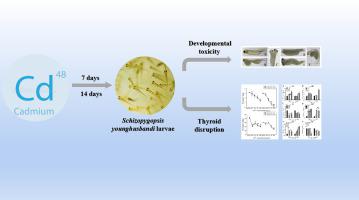当前位置:
X-MOL 学术
›
Comp. Biochem. Physiol. C Toxicol. Pharmacol.
›
论文详情
Our official English website, www.x-mol.net, welcomes your
feedback! (Note: you will need to create a separate account there.)
Thyroid disruption and developmental toxicity caused by Cd2+ in Schizopygopsis younghusbandi larvae.
Comparative Biochemistry and Physiology C: Toxicology & Pharmacology ( IF 3.9 ) Pub Date : 2020-04-25 , DOI: 10.1016/j.cbpc.2020.108783 Fan Yao 1 , Jinping Wu 2 , Huijun Ru 2 , Yunfeng Li 2 , Luyin Wu 2 , Zhaohui Ni 2 , Daqing Chen 2 , Liqiao Zhong 2
Comparative Biochemistry and Physiology C: Toxicology & Pharmacology ( IF 3.9 ) Pub Date : 2020-04-25 , DOI: 10.1016/j.cbpc.2020.108783 Fan Yao 1 , Jinping Wu 2 , Huijun Ru 2 , Yunfeng Li 2 , Luyin Wu 2 , Zhaohui Ni 2 , Daqing Chen 2 , Liqiao Zhong 2
Affiliation

|
In recent years, the adverse effects of cadmium (Cd2+) on aquatic systems have attracted much attention because Cd2+ can induce endocrine disorders and toxicity in aquatic organisms at low levels. However, its effects on the thyroid system in native fish in Lhasa are still unclear. In the present study, Schizopygopsis younghusbandi larvae were exposed to Cd2+ (0.25, 2.5, 25 or 250 μg/L) for 7 or 14 days to determine its toxic effects on thyroid function. The results showed that whole-body total T4 and T3 levels were significantly decreased, which was accompanied by the significant upregulation of the expression of the dio1 and dio2 genes after exposure to Cd2+ for 7 or 14 days. Genes related to thyroid hormone synthesis (crh and tshβ) were upregulated after both 7 and 14 days of Cd2+ exposure, possibly due to the negative feedback regulation of the hypothalamic-pituitary-thyroid (HPT) axis caused by a decrease in thyroid hormone. In addition, survival rates and body lengths were reduced after treatment with Cd2+. This suggests that Cd2+ caused developmental toxicity in Schizopygopsis younghusbandi larvae. An integrated assessment of biomarker response (IBR) showed that there were dose-dependent and time-dependent effects of Cd2+ exposure on Schizopygopsis younghusbandi larvae. Schizopygopsis younghusbandi larvae were sensitive to Cd2+, which caused adverse effects at a concentration as low as 2.5 μg/L. In summary, the results indicated that Cd2+ causes thyroid disruption and developmental toxicity in Schizopygopsis younghusbandi larvae and that wild Schizopygopsis younghusbandi larvae living in the Lhasa River are at potential ecological risk.
中文翻译:

Cd2 +在拟南芥(Schizopygopsis younghusbandi)幼虫中引起的甲状腺破坏和发育毒性。
近年来,镉(Cd2 +)对水生系统的不利影响已引起人们的广泛关注,因为镉(Cd2 +)可以在低水平的水生生物中诱发内分泌失调和毒性。但是,其对拉萨本地鱼类甲状腺系统的影响仍不清楚。在本研究中,裂殖拟南芥幼虫暴露于Cd2 +(0.25、2.5、25或250μg/ L)7天或14天,以确定其对甲状腺功能的毒性作用。结果显示,暴露于Cd2 + 7天或14天后,全身总T4和T3水平显着降低,同时伴随着dio1和dio2基因表达的显着上调。与Cd2 +接触7天和14天后,与甲状腺激素合成相关的基因(crh和tshβ)被上调,可能是由于甲状腺激素减少导致的下丘脑-垂体-甲状腺(HPT)轴的负反馈调节。此外,使用Cd2 +治疗后,存活率和体长都降低了。这表明,Cd2 +引起了裂殖酵母幼虫的发育毒性。生物标志物反应(IBR)的综合评估表明,Cd2 +暴露对拟南芥(Schizopygopsis younghusbandi)幼虫具有剂量依赖性和时间依赖性。裂壁拟南芥幼虫对Cd2 +敏感,其浓度低至2.5μg/ L时会引起不利影响。综上所述,
更新日期:2020-04-25
中文翻译:

Cd2 +在拟南芥(Schizopygopsis younghusbandi)幼虫中引起的甲状腺破坏和发育毒性。
近年来,镉(Cd2 +)对水生系统的不利影响已引起人们的广泛关注,因为镉(Cd2 +)可以在低水平的水生生物中诱发内分泌失调和毒性。但是,其对拉萨本地鱼类甲状腺系统的影响仍不清楚。在本研究中,裂殖拟南芥幼虫暴露于Cd2 +(0.25、2.5、25或250μg/ L)7天或14天,以确定其对甲状腺功能的毒性作用。结果显示,暴露于Cd2 + 7天或14天后,全身总T4和T3水平显着降低,同时伴随着dio1和dio2基因表达的显着上调。与Cd2 +接触7天和14天后,与甲状腺激素合成相关的基因(crh和tshβ)被上调,可能是由于甲状腺激素减少导致的下丘脑-垂体-甲状腺(HPT)轴的负反馈调节。此外,使用Cd2 +治疗后,存活率和体长都降低了。这表明,Cd2 +引起了裂殖酵母幼虫的发育毒性。生物标志物反应(IBR)的综合评估表明,Cd2 +暴露对拟南芥(Schizopygopsis younghusbandi)幼虫具有剂量依赖性和时间依赖性。裂壁拟南芥幼虫对Cd2 +敏感,其浓度低至2.5μg/ L时会引起不利影响。综上所述,









































 京公网安备 11010802027423号
京公网安备 11010802027423号